The Vrouw Maria of 1771 – An example of documentary researchby researcher Christian Ahlström
Introduction
Secondly, there is the historic institution of the Sound Registers in Denmark. This is less well known and has so far been used mainly by economic historians but it is important that it comes to the attention of underwater archaeologists as well. It allows us to study, by way of historical documents, almost the entire traffic of commercial ships through the Danish Sound 1490 - 1856. In the fifteenth century, the Danes started levying a toll on each ship passing through their territorial waters on the way to or from the Baltic, a practice which brought a great deal of revenue to the Danish State Treasury – in the eighteenth century up to 7-8 % annually. It continued as late as the beginning of 1857, when U. S. ships refused to pay the fees and other nations followed suit. Today, the ledgers of the customs officials are kept in the National Archives of Denmark, containing data on cargos, skippers, destinations, ports of departure etc. Readers who wish to give the circumstances and sources mentioned here closer study, may use my book, "Looking for Leads" (Helsinki 1997) for the purpose. It may also be added that my little book "Sjunkna skepp" (Stockholm 1979) contains a chapter giving the complete text of the documents leading to the discovery of the Vrouw Maria which is discussed below. Wreck of the Dutch koff ship at the edge of the Finnish south western archipelago near the island of Jurmo. The wreck is in good condition except that part of the stern is missing. She carries a nearly full cargo, once destined for St Petersburg. The wreck was found by using documentary research and side-scan sonar (SSPC 600 Khz / Marin Sonic Technology, USA). Drawing by Kalle Salonen. Loss of the Vrouw MariaOne of the ships which definitely paid its customs fees at the Sound was the Dutch koff ship, Vrouw Maria in 1771. The entries of the ledgers in the National Archives of Copenhagen leave no doubt about that. She was under the command of one Reynoud Lorenz of Amsterdam, who had left that city with his ship carrying a cargo which in part belonged to the Russian Empress, Catherine the Great. The ship was destined for St. Petersburg with some art treasures, probably paintings and in addition she carried shipments of ordinary merchant goods. The Russian Empress had purchased these in Amsterdam and wanted to take them to St. Petersburg to be included in the collections of the Hermitage. As is well known, the German-born Russian Empress was a great collector of paintings and other art treasures, and her collections in St. Petersburg can still be seen. In October 1771, the Russian Foreign Minister, Count Nikita Panin, sent a letter by courier to Stockholm (to the President of the Royal Chancellery) with a request that the Swedish Government and the King do everything in their power to help the Russians in an unusual matter. The trouble was that a Dutch ship carrying works of art belonging to the Russian Empress and destined for St. Petersburg had foundered in a storm close to the archipelago of south western Finland (which at that time had belonged to Sweden since the 13th century) taking the "numerous crates of paintings belonging to the Empress" which Panin referred to with her. In fact the ship, badly damaged, had anchored some distance from the island of Jurmo after which the crew had attempted to discharge part of the cargo on a rocky little island in the vicinity. Thereafter, a new storm arrived, the anchor cables broke and the ship disappeared. The author found a microfilm copy of Panin´s letter in the Finnish National Archives in the 1970`s and went to Stockholm in the hope of finding more material regarding these events. There is reason to believe that, besides the paintings, there may have been other items of value on board the wreck: silver and lacquer works, bronze statues, ivory works, even furniture. The Russian Empress had bought her paintings from an auction held on the 31st of July 1771, following the death of Gerret Braamcamps, a Dutch timber merchant who had been a famous art collector. A few days later, silver, porcelain, lacquer works and other antiquities had also been auctioned off, but there is no definite documentation on the Empress buying any of these items.
Artist's view of the bow of the wreck. Drawing by Tiina Miettinen, Maritime Museum of Finland. In the National Archives in Stockholm it was found that an intensive correspondence on the matter had taken place in 1772, after the receipt of Count Panin`s letter. There are even some letters dating from 1773. The correspondents had been Swedish Government officials in Stockholm, local officials in Åbo (Turku), the provincial capital of Finland, and members of the Swedish Embassy in St. Petersburg. The Russians evidently used the Swedish Ambassador, Count Ribbing, as their correspondent when they wished to say something to the Swedes. In addition to these documents, the protest and declaration given on August 26th 1771, by the Dutch captain and his crew was found in the archives of the city court of Åbo (Turku). This document included the log book of the Vrouw Maria which was a great help later, when it was necessary to establish an area of search in which to try to find the wreck. It was also valuable because it informed us that the Vrouw Maria had lost her rudder when striking a rock, a piece of knowledge which would be important later on when the right ship was found and she had to be positively identified. Swedish local officials did what they could, and tried on several occasions during the summer of 1772 to find the shipwreck without succeeding. With the primitive tools available in those days this is not surprising, as the wreck was as deep as 43 meters.
Artist's view of the bow of the cargo hold, many claypipes visible. Drawing by Tiina Miettinen, Maritime Museum of Finland. Preparatory researchAt this stage documentary research could take us no further in terms of localizing the probable site. In 1979, I published the results (Sjunkna Skepp, Stockholm 1979), followed by a Finnish translation, Syvyyksien Sylistä, Hämeenlinna 1982.) In those days the echo-sounding technique was not developed enough to find the physical remains of the wreck. I carried on with my historical research, and concentrated on other ships, many of them in Sweden, almost forgetting about the Vrouw Maria.
Years later, a diver and side-scan operator, Mr. Rauno Koivusaari, contacted me. Having read the story, he had become interested and we decided to join forces to find the wreck. The plan was to delimit an area, and then systematically search through it with a side-scan sonar. The procedure may be likened to an airplane continuously making pictures of the ground. The airplane corresponds to the search vessel, moving along the surface, the camera of the airplane is equal to the side-scan sonar and the ground is analogous to the seabed. Pictures made this way are clear and of a high quality, being continuously stored in the memory of the sonar machine. I had met Koivusaari before, in the summer of 1998, when an association of divers made an attempt at finding the remains of the ship using side-scan sonar operated by Koivusaari. We did find a shipwreck from the same period as the Vrouw Maria, but it was empty and the rudder was intact, so it could not have been the right ship. The campaign of 1998 had scanned a could not have been the right ship. The campaign of 1998 had scanned a large part of the search area, but there was no Vrouw Maria. The year 1998 was nearing its end and we started planning the next campaign in the following summer. The main trouble was that we knew very little about the physical appearance of the Vrouw Maria, and might have difficulties identifying her if she was found. We decided to make another attempt to find new archive material. But this time the point of departure had to be in the archives of the Netherlands. We were particularly keen on finding the main measurements of the Vrouw Maria, her length and beam, for instance, in order to be able to distinguish her from the other wrecks that we might encounter. I felt that the information of the log concerning the missing rudder had to be supplemented with something else before a satisfactory identification could be established.
There was a problem, though. The additional information we needed to give us a sound basis of facts to make our decisions about the wreck when we found it, without having to resort to any guesswork, would require studies in a Dutch archive. It would probably be the Gemeente archief of Amsterdam. I did have some experience of documentary research, and had even published a few books on it, including a doctoral dissertation. But I had always concentrated mainly on the Baltic area, making only occasional minor expeditions into French, Dutch and German archives. But this time it would require intimate knowledge of the enormous collections of Dutch maritime documents, good knowledge of the 18th-century version of a foreign language, maybe even knowledge of the local history of Amsterdam. Clearly this foreign research was not a case for me, it would have to be done by a Dutch professional historian. I thought I knew which archive in the Netherlands would contain the data we needed. Of course, they had to be searched by someone, but by whom? I decided to approach the Dutch Ambassador to Helsinki, Jacobus van der Velden, who was kind enough to personally telephone the archive in Amsterdam. The result was that the head of the section of Maritime Manuscripts set to work finding information on this 18th-century ship. The first difficulty in these archive studies was that of distinguishing between Vrouw Maria, skippered by captain Lorenz and the large number of ships of varying sizes with the same name, but other skippers. The most interesting find was a sales contract dated August 18, 1766 (sales of ships through brokers, file nr 5071, Gemeente archief Amsterdam). This document mentions the koff ship Vrouw Maria (length 81 1/4 feet, breadth within hull 20 feet 5.5 inches, Amsterdam feet of 0.283 meters, inches 2,573 cm each.) Our belief that the type of ship was a snow (snau or snaauw) proved to be wrong. The ship had been a snow but after being rebuilt in 1748, she was equipped with the rig of a koff ship. Later, it was discovered that the mainmast of the wreck bore traces of the fittings of the snowmast which had been removed when the ship was rebuilt. The total number of records containing data on the ship, her owners or cargo amounts to 31 entire documents referring exclusively to this ship or entries in public records of a more general nature. It may be mentioned that several owners of the cargo had insured their possessions being shipped to St. Petersburg, but no information on any further implementations or procedures regarding these acts was found. We received this information in May 1999 with a batch of seventeen documents of different length. It was interesting to note that some of the cargo-owners had insured their merchandise for the sea-transport to St. Petersburg, but unfortunately no data on further developments after the loss could be found. Boxes in Vrouw Maria´s cargo hold. Samples of the white sediment in the open box showed high contents of sulphur bacteria. Photo: Jouni Polkko, Maritime Museum of Finland. Finding the wreckIn June 1999, the side-scan operators set out from Helsinki in their former trawler the Teredo. Upon reaching the search area a few days later they began to work. After only three hours of systematic study of the sea-floor a promising echo was found, divers we re sent down and came back reporting that the wreck of a wooden ship had been found. She corresponded to the measures mentioned above and her rudder was missing. She was lying there in a depth of 41 - 43 meters in almost perfect condition, and with the two lower masts still standing. Later in the day it was discovered that she carried an almost full load of crates, barrels etc. with an unknown content. (One of the many problems with unloading the cargo will probably be that there is very little space between the cargo and the deck.) Being one of the non-diving members of the team, the author missed this memorable moment, to his great disappointment, but was notified immediately by mobile phone. It may be mentioned that one small kedge-anchor with a missing fluke was found hanging on the side. Apparently the same kedge anchor with the missing fluke was mentioned in an inventory of the ship´s gear. This document, particularly mentioning the defect of the anchor is dated August 18th, 1766, five years before the loss. The wreck of the Dutch or Russian frigate-rigged galliot, St. Michael, (1747) rests on the sea-floor only about a dozen nautical miles away. This wreck of roughly the same size was found about 50 years ago by some fishermen`s nets catching on her near the island of Borstö, in an equally good state of preservation. She had been loaded with snuff boxes, watches, a cross staff, lots of valuable Meissen-porcelain from the first half of the eighteenth century etc. but also normal merchandise like textiles, wine, and other consumer goods. The depth of the site is about 38 meters. The conclusion we arrive at when studying these two wrecks and comparing them with those in shallower waters and closer to the mainland is obvious. The ships which have foundered in deep water are very much better preserved, due to the fact that there has been no contact with ice due to the great depth. A few more lines about the Vrouw Maria: as required by law a report was radioed to the museum officials in Helsinki. Only three finds were lifted from the ship last summer: a metal ingot, an ordinary 1800-century clay pipe made in Gouda, and a lacquer seal, giving the initials of a textile manufacturer in Leyden, the Netherlands. These are perhaps not very exciting finds as might be expected, since they we re only lying around on the deck. Only the pipe could be reached through the hatch, which had been left open by the crew in 1771, when they attempted to bring as much as possible of the cargo ashore in their launch before the ship sank.
When the Vrouw Maria passed through the Danish channel of Öresund in September 1771, she had to pay a customs fee on most of the merchandise making up her cargo. It may be mentioned that royal property was usually granted exemption from the customs fees. One of the items which is marked down in the entry concerning the ship in the customs ledgers (23rd September 1771, Dutch ship no. 508) is a shipment of zinc. I had thus already guessed, when the recovered metal ingot was sent for analysis to a metallurgist, that it was going to be zinc. So it was. The ability of documentary research to supplement the findings of post-medieval archaeology was proven again. Practically no physical archaeological research has been performed as yet on the wreck of the Vrouw Maria, which in view of the short period that has elapsed since the find was made is perfectly understandable. Let me finish this short essay by pointing out a thought of a more general nature which has often come to my mind and especially while working with this case. It is true that, as a rule, there is a correlation between the size of a lost ship and the number of documents giving information about the accident. However, this case is exceptional, the ship being comparatively small, (less than 1/3 of the Vasa), but the importance of one of the cargo-owners makes the amount of information considerable. We may not know very much about the Vrouw Maria yet, but we do know at least something. We know her position, we know a good deal about her cargo, listed by the Danish customs officials, we know her type, the circumstances leading to her loss, etc. I f it had been necessary to gather even this amount of information about her by solely archaeological methods, how much time would it have consumed and what would it have cost? Archaeology has gladly incorporated with her box of tools, methods which really originate from the natural sciences. But the age-old, inexplicable animosity between history and archaeology has so far allowed only lukewarm relations between these two sciences. I do not, for obvious reasons, propose any cooperation between prehistorical archaeology and history. But post-medieval archaeology, perhaps especially the sub-marine brand, why not? If any reader can tell me why not in a convincing way I would indeed be most grateful. Christian Ahlström Related textRelated link |
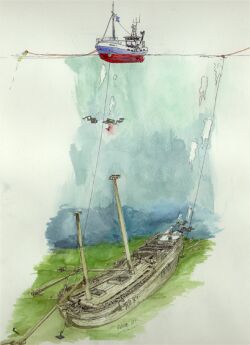
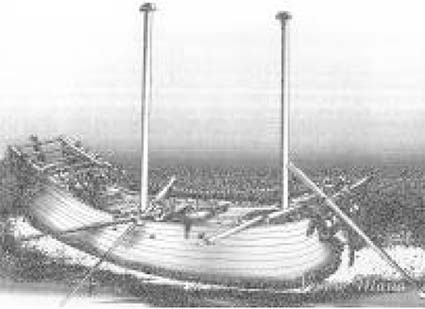
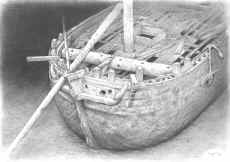
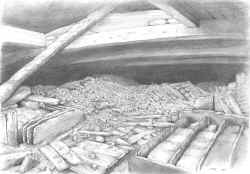
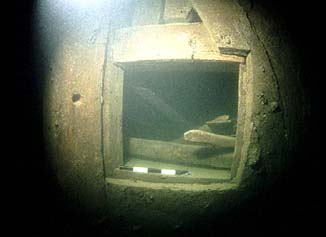
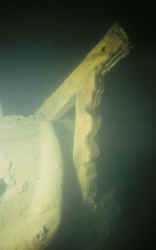
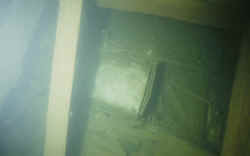
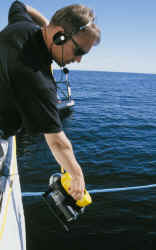
 Back to Nordic Underwater Archaeology
Back to Nordic Underwater Archaeology